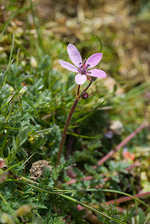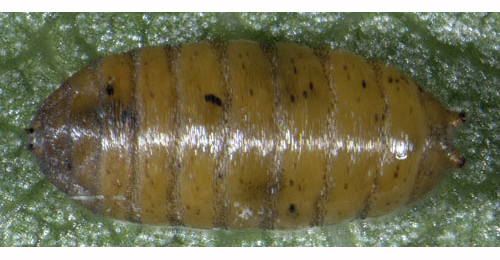|
||||||
|
ERODIUM. Stork's-bills. [Geraniaceae] |
|
|
Thirty-seven species of Erodium are recorded in Britain including the native species Common Stork's-bill (E. cicutarium), Sticky Stork's-bill (E. lebelii), Sea Stork's-bill (E. maritimum), Musk Stork's-bill (E. moschatum) and E. x anaristatum. The BSBI provide a downloadable plant crib for Erodium. Two British miners are recoded on Erodium. A key to the European miners recorded on Erodium is provided in Bladmineerders van Europa. |
 Common Stork's-bill Erodium cicutarium |
|
Key for the identification of the known mines of British |
1a > Leaf-miner: An initially narrow linear mine which after the first moult widens into large linear or irregular blotch; frass in distinct rows in the early linear section, later more scattered (Spencer, 1976: 128-9, fig. 221). The mine is described by Hering (1957a) as follows: Upper-surface mine. The start is corridor-like and generally follows the leaf margin. Further on the mine widens considerably, forms a secondary blotch and gets irregular sides that are deeply eaten out. Primary and secondary feeding lines clearly visible. Frass mostly in large clumps. Pupation outside the mine. The mine only rarely occurs in Geranium robertianum; the frass then is fine-grained and the mines are smaller. Hering didn't think it impossible the the miners of Geranium robertianum and the other Geranium species might be a different species. Dutch material might form a different third species. The first instar larva makes an initial corridor, with frass in two lines. Then a large irregular blotch is formed. |
 Agromyza nigrescens puparium Image: © Willem Ellis (Bladmineerders van Europa) |
|
|
1b > Leaf-miner: In the first instar the larva mines the leaves, forming short, irregular, blotch-like mines, but in later instars it lives externally, feeding in spun leaves and often twisting those of tender shoots. Larval head light-brown or yellowish brown, edged with black postero-laterally, ocellar area blackish; prothoracic plate black edged with whitish anteriorly; abdomen dull dark green; pinacula distinct, black, sometimes brownish but with black bases to setae; anal plate large, black (Bradley et al., 1973). Small, full depth mine without a definite shape; little frass. Some silk is deposited in the mine. The larva soon leaves the mine and continues feeding among spun leaves. |
|
Cnephasia incertana (Treitschke, 1835) [Lepidoptera: Tortricidae]. |
| Last updated 04-Jul-2019 Brian Pitkin | ||
